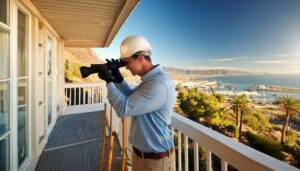What EEEs are subject to SB-326 inspection?
Table of Contents
What Exactly is an EEE? A Closer Look
The Importance of Expert Inspection: Beyond the Checklist
FAQ Section: Top Questions & Answers
If you manage or own a condo building or HOA-governed property in California, you’ve likely heard the buzz about SB-326. But while many mistakenly believe it’s only about “balcony inspections,” the reality is much more expansive. The law’s reach extends to a variety of “exterior elevated elements” (EEEs), ensuring the safety and compliance of these vital components.
What Exactly is an EEE? A Closer Look
In simple terms, an EEE is any part of your building that’s raised above the ground and intended for human use or occupancy. Think of it as anything you might step out onto or walk across that’s not at ground level. SB-326 casts a wide net to ensure the safety of these elements.
Here’s a breakdown of the usual suspects:
- Balconies: While often the focus of discussion, balcony inspections under SB 326 encompass far more than just the visible surface. Inspectors assess the entire structure, from railings and decking to the underlying support beams and connections.
- Decks: Whether they’re shared common areas or attached to individual units, decks exceeding six feet above the ground must be inspected. Inspectors check for structural integrity, proper drainage, and any signs of deterioration.
- Walkways: Elevated walkways connecting different sections of your property also fall under the EEE umbrella. These high-traffic areas need to be assessed for safety, with a focus on structural soundness, railing integrity, and trip hazards.
- Stairs: Any exterior stairs leading to balconies, rooftop decks, or other elevated areas are subject to inspection. Inspectors will check for loose railings, damaged treads, adequate lighting, and overall stability.
- Guardrails and Railings: These aren’t just aesthetic features; they’re crucial safety components. Inspectors meticulously check their height, design, and structural integrity to ensure they meet California’s stringent safety standards.
- The Unexpected EEEs: Beyond the obvious elements, SB-326 can also extend to certain attached structures like awnings, pergolas, or even light fixtures that are elevated and accessible. Inspectors assess these to ensure they’re securely attached and pose no safety risks.
Contact DrBalcony for a professional inspection!
Ensure the safety of your balcony and living space with DrBalcony – We’re a Tech Engineering firm that specializes in California SB326 & SB721 balcony inspections. Over 300+ completed projects in California.
Request A Free EstimateClick To Call
The Waterproofing Element
It’s not just the visible structure that matters. SB-326 inspections also scrutinize the waterproofing systems associated with these elevated elements. This includes flashing, sealants, membranes, and any other materials designed to prevent water intrusion.
Why is waterproofing so crucial? Because water damage is a silent killer. Leaks can lead to rot, mold, and corrosion, compromising the structural integrity of your balconies and other EEEs over time. A thorough inspection will identify potential water intrusion points and recommend solutions to keep your building dry and safe.
The Importance of Expert Inspection: Beyond the Checklist
While the above list gives you a good overview, the intricacies of SB-326 compliance can be complex. That’s where partnering with a knowledgeable inspection company like DrBalcony becomes invaluable. Our experienced team understands the nuances of the law, ensuring a thorough assessment and a comprehensive report that outlines any necessary repairs.
Don’t leave your property’s safety and compliance to chance. Contact us today to schedule your SB-326 inspection and safeguard your investment.
Contact DrBalcony for a professional inspection!
Ensure the safety of your balcony and living space with DrBalcony – We’re a Tech Engineering firm that specializes in California SB326 & SB721 balcony inspections. Over 300+ completed projects in California.
Request A Free EstimateClick To Call
FAQ Section: Top Questions & Answers
My property is well-maintained. Do I really need SB-326/SB-721 inspections?
YES! Even with excellent maintenance, hidden issues can develop due to construction errors, material flaws, or severe weather exposure. Inspections are about ensuring those don’t turn into major problems.
Our balconies were inspected a few years ago – isn’t that enough?
Unfortunately, no. California laws mandate inspections on a set schedule, often every 6 years. Deterioration can happen quickly, making regular assessments essential.
Can I use my regular handyman for the balcony inspection?
It’s not recommended. Unless they hold specific licenses (architect, structural engineer, etc.) their inspection won’t be considered valid for SB-326/SB-721 compliance.
What if the inspection uncovers major issues?
First, don’t panic! Early detection often means less extensive (and expensive) repairs are needed. Work with your inspector to prioritize fixes, and explore if they offer repair services for a streamlined solution.
I’m worried about the cost of inspections. Are there any resources to help?
Start by getting detailed quotes from multiple companies. Factor in that proactive inspections help you avoid even bigger costs down the line due to neglected problems. Some property management associations offer guidance on budgeting for balcony compliance.



